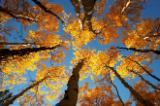 © Mike Norton (Colorado)
© Mike Norton (Colorado)

Conservation Overview
There are many ways to describe Colorado’s natural history, but none so evocative of the state's true essence as Dr. Dave Armstrong’s Foreword to From Grassland to Glacier: the natural history of Colorado and the surrounding region, by Cornelia Fleischer Mutel and John C. Emerick. The following excerpt from that book paints a picture of Colorado sure to inspire the will to conserve and protect:
“…The Rocky Mountains are the ruling motif in Colorado, the dominating presence, the driving force. Mountains are central to the state’s diversity. Visitors and residents alike are drawn almost instinctively to the mountains. Mountains are fundamental to local ecology. They allow a diversity of landscapes greater than any other inland state. The mighty ridge of the Rockies is highest here and stands farthest east. Here it rises most abruptly from the plains and canyons and plateaus. High relief dictates a wide range of physical conditions which provide a wide range of opportunity. Colorado is built of recycled mountains. The eastern plains are bits of mountain worn by the ages and integrated by life into ecosystems. The western valleys are carved by mountain water through sediments derived from generations of Rocky Mountains long past.
We are drawn naturally to the mountains, their magnificent scale, their commanding presence. Most human intervention leaves mountains fundamentally unscathed. To really know Colorado, however, we have to look close. At smaller scales, human impact can be greater, human interaction more moving. Look, live, and know it better. Know it better to be the more tenacious in your grip on its wonders, its opportunities for enrichment.
Know Colorado beyond science. Know the damp, musty cool of a spruce forest in thaw, the mournful soliloquy of the hermit thrush through a subalpine fog. Breathe the richness of the sagebrush somewhere west of Maybell. Watch and wonder at the aerobatic flight of pelicans over an oxbow lake along the Platte, coursing as one, disappearing into the noonday sun, to reappear as magically as they had vanished. Hear a coyote howling to his colleagues and a frosty October moon. Delight in a beetle’s mechanical tracks in the sand in Glade Park. Watch beavers pushing through the Yampa, working hard to change the course of history. Know spring’s first sun climbing resolutely up Green Ridge, illuminating new opportunity in a tender land, tamed by generations of loving hands but not subjugated. Feel dew on the grass on Wilson Mesa changing through frost to steam at dawn. Know a meadowlark calling to a prairie dawn at Pawnee Buttes, a great blue heron plodding homeward, tired but honest, to his half-dead cottonwood, a harrier hovering over a North Park marsh.
Colorado is as icy harsh as wind-driven snow flailing the last heads of grama on a prairie rise, as gentle as the freshness of air after a “one-inch rain” – flat sweet drops an inch across and an inch apart – settles the red dust in the rabbitbrush out beyond Rifle. Colorado is a bright as the Sand Dunes under a full moon, as bright as snowflakes against a late-lying drift of precious winter moisture, as dark as bats working Deep Canyon at dusk, as dark as a moonless prairie night after the lightning has gone.
The images that inspire us to cherish this place are but superficial glimpses, momentary cross-sections through processes of Life and Earth. Know them to keep them steady and whole.
Colorado first was occupied by humans some 10,000 years ago. The last century – just 1 percent of the total tenure of humans here – has been particularly influential. We have changed the color of the sky and made water flow uphill. We have paved and plowed and fouled our nest in myriad ways. But some things still are right. We have a fair measure of wildness left. There are pronghorn out at the Plains Conservation Center keeping a wary eye on the expanding metropolis that is the “Queen City of the Plains.” Prairie dogs burrow up through the new asphalt of a pretentious but plastic shopping mall. A wily and playful marten follows a right-minded backpacker through the subalpine forest. Can it wonder, I wonder, why all people cannot walk lightly on the Earth? Our remaining wildlands have the capacity to lend perspective. Know them better to keep them free.
Colorado is a stubborn land that has molded a stubborn and resilient life. Stubborn cattlemen (and women) on hardscrabble ranches and stubborn farmers on dryland farms; sheepherders, more stubborn still, Basque and Mexican, and Native American. Stubborn lichens taking on the Flatirons; stubborn piñons, squeezing a worthy life out of bare slickrock.
…Walk lightly here. Know as much as you can. Get as stubborn as the natives: the Utes, the bristlecone pine, imperious owl, imperial elk. Respect the genius of this place. Pass it on intact to enrich another generation.”





